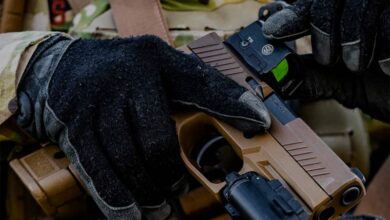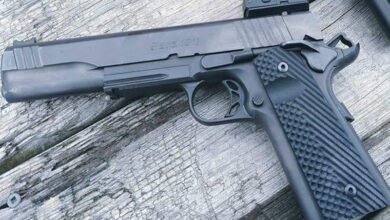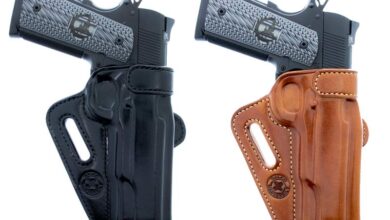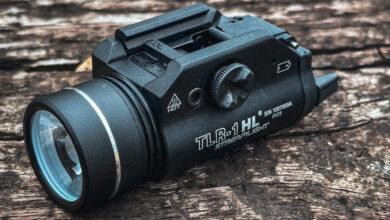Ruger Mini-14 Factory 20-Round Magazines: A Review

Aftermarket magazines are often sufficient for our needs, but if you’re like me, there’s just nothing quite as satisfying as having factory magazines for your rifle or pistol. Factory magazines can be counted on to be in perfect specification for the firearm they were made for.
But before we dive into the Ruger factory Mini-14 magazine, let’s briefly reacquaint ourselves with the rifle itself, the Mini-14.
Ruger’s Mini-14 was first introduced back in 1974 when they scaled down the military’s M-14 and chambered it in .223 Remington. While both rifles might share similarities on the outside, the Mini-14’s gas system is different than that of its full-sized big brother. The rotating bolt, however, is very similar to the original M-14’s.
Back then, Bill Ruger intended the Mini-14 to be an affordable, working man’s rifle, priced at less than $200. Immediately, it became popular, largely owing to the M-14 that it was patterned after. Veterans could own a scaled-down version of the rifle that many of them had used in the service. The fact that it used a conventional-looking, wooden stock and did not resemble the M-16 was also likely a big selling point since not everyone wanted a futuristic-looking rifle with plastic stock and furniture. Back in the wonderful era of the 1980s, a television show called the A-Team made the Mini-14 in stainless steel with the side-folding factory stock a household image.
Magazine Function
When the magazine is inserted into the Mini-14, it is inserted front first and then rocked into place, similarly to the M1A and the AK-47 platforms. It takes a little practice to become adept at this. To eject the magazine, grab it while depressing the ejector tab with the thumb and rock the magazine forward to withdraw it. It’s not as fast as the AR-15 ejection system, but it works well enough.
Size and Accuracy
The overall length of the Mini-14 factory folder is approximately 38 inches. The sights are very simple, with the rear being an aperture and a front sight blade. Accuracy is acceptable for a semi-auto rifle. I know the Mini-14 has been criticized for a long time for being “not accurate enough,” just like the AK-47. Truth be told, the Mini is more accurate than most AKs, and groups of around 4 inches for the Ruger at 100 yards are probably about average.

At realistic engagement distances, the Ruger is probably more accurate than those who are shooting it. In fact, during the 1986 “FBI Shootout” in Miami, Michael Platt used a folding stock Mini-14 to murder two agents and wound several more. The Mini’s effectiveness at close quarters was once again proven, unfortunately, by a bad guy in this instance.
The .223/5.56mm version of the Mini-14 has very little recoil and can land hits quite rapidly on target.
Updates
Since it was introduced, the Mini-14 went through several changes and updates. In 1982, the Ranch Rifle version was introduced, which had attachment points for mounting a scope to wring more accuracy out of the rifle. The Mini-30 was released in 1987 and was chambered for 7.62x39mm.
Ruger is still making the Mini-14, and there are some interesting developments currently. One of the biggest is that they’ve once again introduced their factory folding stock, which many people have been yearning for. Also, aside from being chambered for 5.56mm NATO now, it’s available in .300 Blackout.

Despite Bill Ruger’s intention for the Mini-14 to be an affordable rifle for the working man, the new rifle with folding stock is currently offered for $1,849 MSRP. Of course, it will cost less at local gun shops, but that’s still quite a whopping price tag, especially compared to other semi-auto options on the market.
Popularity
Despite the salty price tag, I predict they’re going to be flying off the shelves. Why? They are just that cool. The folding stock looks neat and works pretty well when the rifle is shouldered. Beyond that, when it’s folded, it makes the Mini-14 very compact and easy to stow away. The fact that Ruger had stopped making these factory-folding stocks for a long time made people want them even more (the old supply and demand equation). Or, if you prefer, absence makes the heart grow fonder.
I did a quick internet search and discovered that, as predicted, the new Mini-14 with factory folding stock is as rare as hens’ teeth. The same is true of local gun shops; they just cannot be found. You’ll have more luck expecting the Tooth Fairy, Santa Claus, and Frosty The Snowman to show up at your birthday party than finding one of these rifles locally. If you do, snap it up (after remortgaging your house, of course).
Magazines and Ammo
I like the fact that Ruger is made in the United States, as are the 20-round magazines that we tested. As mentioned, factory magazines are the very best because they are made by the Mini-14’s creators just for this rifle.
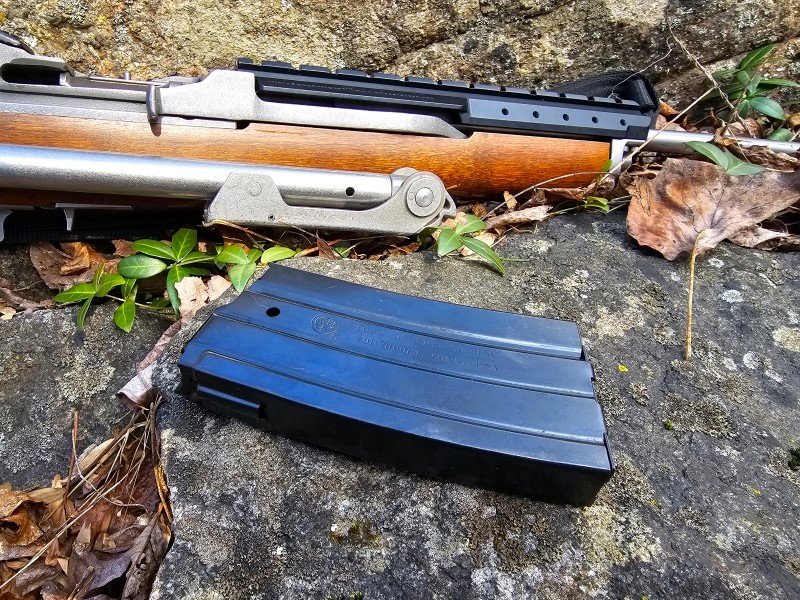
The construction of the magazines is among the best of any commercially available mags in the world. They’re composed of blued steel and are thick enough to be sufficiently durable without adding excessive weight. Magazine followers are made from polymer, and they just glide along the inside of the magazine, which contributes to perfect reliability. The base plate is also steel for durability. The spring used is steel wire and will last for decades. I’ve personally seen these magazines continue functioning through several decades of consistent use.
Yes, you can get aftermarket magazines for your Mini-14, but in my experience, they’re not always the most reliable thing available. The factory Mini-14 mags have proven to be far more reliable and durable. As this is written, they’re available for $34.99. While that’s not dirt-cheap, the old adage applies: “Buy once, cry once.”
Personally, I love 20-round magazines because they are short and compact while still holding a respectable amount of ammo.
For this range session, we elected to use Remington’s UMC .223 ammunition. UMC stands for Union Metallic Cartridge Company, which was founded in 1867.
I’ve been using this ammunition for several years, and it has proven reliable, accurate, and clean. Overall, it’s a good value.
For this range session, we weren’t shooting for groups, but rather, we rang some steel at moderate ranges. The little rifle performed admirably, as did the 20-round magazines.
Final Thoughts
If you own a Mini-14, my best recommendation is to get factory magazines. They’re built durably and will last for at least as long as you will, and probably longer. If the magazine is dropped on the ground, it’s not going to break and fly apart.
Feeding and reliability are utter perfection with these magazines, too, which makes them worth every penny. Ruger manufactures some of the best magazines on the market. They may not be the cheapest, but these days, you get what you pay for.
Overall, the Mini-14 is a good rifle, and factory magazines are definitely one of the positive points of the platform.
The post Ruger Mini-14 Factory 20-Round Magazines: A Review appeared first on The Mag Life.
Read the full article here


